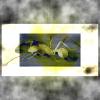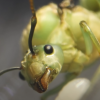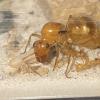I have a cone ant colony that's almost two years old. The colony has several hundred workers and heaps of brood. They are so small and yet so industrious. They have sculpted all of the sand I gave them into a complex tunnel system in their outworld and even made a "cone" to cover the entrance to their nest. (Are they called "cone ants" for the little cone on their thorax... or because they build cone-shaped mounds?)
The queen still has her wings, she is very beautiful.
I have a few questions about these ants. First, are there any special foods they prefer? I find that they tend to put sand on any honey or fruit that I offer them. They clogged up the tiny sugar water feeder with sand -- But, I worry that they need some sugar in their diets so keep offering sweets from time to time. They love fruit flies and bits of insects, and this is mostly what I feed them.
Second, are these normally panic-prone ants? I have had multiple occasions when the queen has run out of her test tube in a panic as all the workers pick up the brood and form a conga line leaving the nest... then they realize there is no where to go and go back inside. This happens if there are vibrations... though some vibrations don't spook them while others do... it's not the intensity that sets them off... but I still don't know exactly what triggers this "grab the young and leave!!" response.
I've given them a second nest to store brood so at least now they have a place to run to when they get scared, but I'd rather know how to avoid spooking them. Again, it's not just any loud noise or bumping the outworld that set them off, I think it might be scraping that they really dislike... but I'm not certain.
Edited by futurebird, June 18 2023 - 10:23 AM.



















